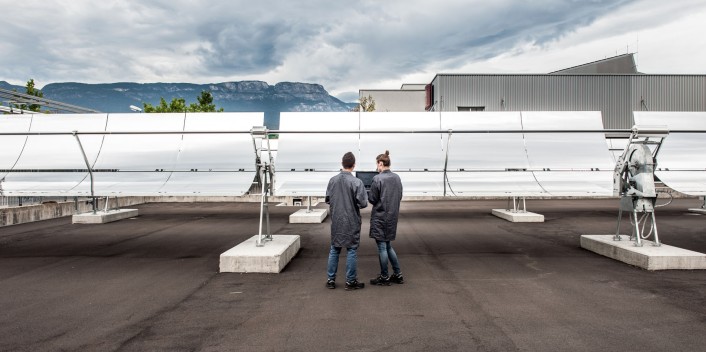Everything you need to know as a company
We want to optimise district heating and cooling systems.
We recreate the concept of the systems: from heat production to final consumption.
Our researchers in the Energy Exchange Lab examine traditional district heating and cooling systems under real conditions. We also have expertise in the field of low-temperature networks, in which heat sources with different initial temperatures (from 30°C) can be combined. We reproduce the operations of the systems on a small scale: from heat production to distribution to consumption by the end user. This makes it possible to study optimal grid management, as well as the provision of heat from multiple sources. The flexible infrastructure enables a wide range of configurations as well as tests on hardware and control software.
We test combined heat, power and cooling for thermal and electrical energy.
The outdoor area of the laboratory houses the district heating network and a thermal solar system. The indoor area is divided into two parts and houses the power generation system and the heat transfer stations. The power generation system is coupled with the solar thermal system and consists of a gas boiler, an Organic Rankine Cycle (ORC) unit and an absorption chiller. This combination allows a grid-connected trigeneration system to be replicated and tested, making it possible to study and optimise the use of a non-programmable source of thermal and electrical energy.
Two electric heat pumps allow us to simulate the behaviour of consumers who take heat from the grid or feed heat into the low-temperature grid. In this way, we can investigate interfaces where end users can extract energy for heating and hot water production and feed energy back into the grid when the heat pump is inverted.
Testing solutions: our test laboratory for innovative cooling and heating technologies.
In this laboratory, control systems are tested, as well as the functionality of and interaction between the various control modules, both at the level of the circuit’s individual components and throughout the system. In addition, the facility serves as a testing laboratory for innovative technologies such as mini ORCs, absorption chillers and absorption heat pumps that operate with liquid heat transfer media at temperatures up to 250°C or heat transfer stations in a district heating network.
Go to website
















